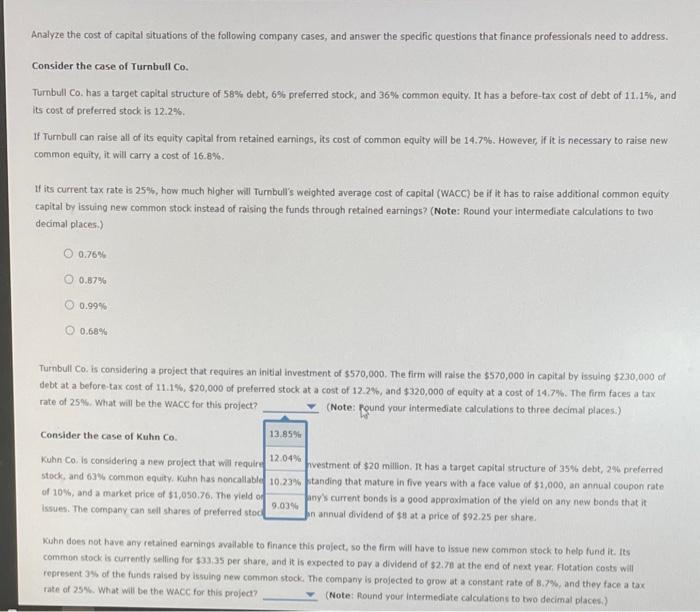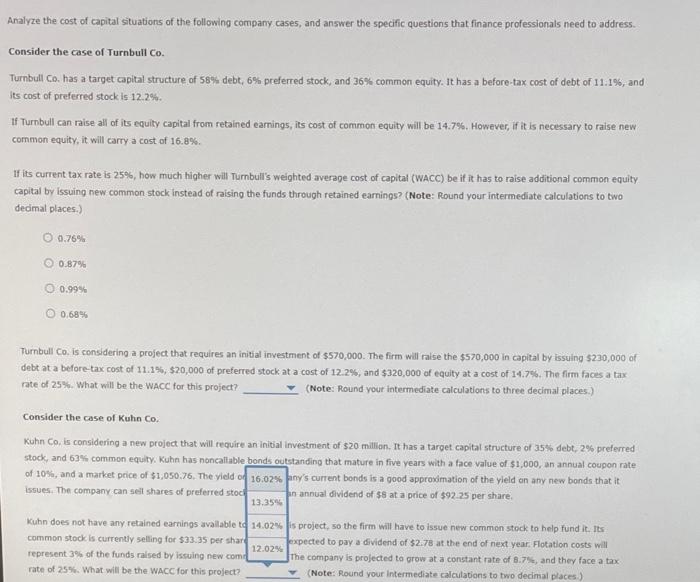Analyze the cost of capital situations of the following company cases, and answer the specific questions that finance professionals need to address. Consider the case of Turnbull Co. Turnbull Co. has a target capital structure of 58% debt, 6% preferred stock, and 36% common equity. It has a before-tax cost of debt of 11.1%, and its cost of preferred stock is 12.2%. If Turnbull can raise all of its equity capital from retained earnings, its cost of common equity will be 14.7%. However, if it is necessary to raise new common equity, it will carry a cost of 16.8%. If its current tax rate is 25%, how much higher will Turnbull's weighted average cost of capital (WACC) be if it has to raise additional common equity capital by issuing new common stock instead of raising the funds through retained earnings? (Note: Round your intermediate calculations to two decimal places.) O 0.76% O 0.87% 0.99% 0 0.68% Turnbull Co. is considering a project that requires an initial investment of $570,000. The firm will raise the $570,000 in capital by issuing $230,000 of debt at a before-tax cost of 11.1%, $20,000 of preferred stock at a cost of 12.2%, and $320,000 of equity at a cost of 14.7%. The firm faces a tax rate of 25%. What will be the WACC for this project? (Note: Round your intermediate calculations to three decimal places.) Consider the case of Kuhn Co. Kuhin Co. is considering a new project that will require an initial investment of $20 million. It has a target capital structure of 35% debt, 2% preferred stock, and 63% common equity. Kuhn has moncallable bonds outstanding that mature in five years with a tace value of $1,000, an annual coupon vate of 10%, and a market price of $1,050.76. The yield on the company's current bonds is a good approximation of the yield on any new bonds that it issues. The company can sell shares of preferred stock that pay an annual dividend of $8 at a price of $92.25 per share Kuhn does not have any retained earnings available to finance this project, so the firm will have to issue new common stock to help fund it. Its common stock is currently selling for $33.35 per share, and it is expected to pay a dividend of $2.78 at the end of next year. Flotation costs will represent of the funds raised by issuing new common stock. The company is projected to grow at a constant rate of 6.75, and they face a tax rate of 25%. What will be the WACC for this project? (Note: Round your intermediate calculations to two decimal places.) Analyze the cost of capital situations of the following company cases, and answer the specific questions that finance professionals need to address. Consider the case of Turnbull Co. Turnbull Co. has a target capital structure of 58% debt, 6% preferred stock, and 36% common equity. It has a before-tax cost af debt of 11.1%, and its cost of preferred stock is 12.2% If Turnbull can raise all of its equity capital from retained earnings, its cost of common equity will be 14.7%. However, if it is necessary to raise new common equity, it will carry a cost of 16.8% If its current tax rate is 25%, how much higher will Turnbull's weighted average cost of capital (WACC) be if it has to raise additional common equity tapital by issuing new common stock instead of raising the funds through retained earnings? (Note: Round your intermediate calculations to two decimal places.) O 0.76% 0.87% 0.99% 0.68% Turnbull Co. is considering a project that requires an initial Investment of $570,000. The firm will raise the $570,000 in capital by issuing $230,000 of debt at a before-tax cost of 11.1%, $20,000 of preferred stock at a cost of 12.2%, and $320,000 of equity at a cost of 14,7%. The firm faces a tax rate of 25%. What will be the WACC for this project? (Note: Pound your intermediate calculations to three decimal places.) Consider the case of Kuhn Co 13.85% Kuhn Cols considering a new project that will required 12.04% nvestment of $20 million. It has a target capital structure of 35% debt, 29 preferred stock, and 63% common equity, Kuhn has noncallable 10.23% standing that mature in five years with a face value of $1,000, an annual coupon rate of 10%, and a market price of $1,050.76. The vield of pony's current bonds is a good approximation of the yield on any new bonds that it Issues. The company can sell shares of preferred stod 9.03% in annual dividend of $8 at a price of $92.25 per share Kuhn does not have any retained earnings available to finance this project, so the firm will have to Issue new common stock to help fund it. Its common stock is currently selling for $33,35 per share, and it is expected to pay a dividend of $2.70 at the end of next year. Hotation costs will represent 3% of the funds raised by issuing new common stock. The company is projected to grow at a constant rate of 8.7%, and they face a tax rate of 25%. What will be the WACC for this project? (Note: Round your intermediate calculations to two decimal places) Analyze the cost of capital situations of the following company cases, and answer the specific questions that finance professionals need to address. Consider the case of Turnbull Co. Turnbull Co. has a target capital structure of 58% debt, 6% preferred stock, and 36% common equity. It has a before-tax cost of debt of 11.1%, and its cost of preferred stock is 12.2% If Turnbull can raise all of its equity capital from retained earnings, its cost of common equity will be 14.7%. However, if it is necessary to raise new common equity, it will carry a cost of 16.8%. If its current tax rate is 25%, how much higher will Turnbull's weighted average cost of capital (WACC) be it it has to raise additional common equity capital by issuing new common stock instead of raising the funds through retained earnings? (Note: Round your intermediate calculations to two decimal places.) 0.76% 0.87% 0.99% O 0.68% Turnbull Co. is considering a project that requires an initial investment of $570,000. The firm will raise the $570,000 in capital by issuing $230,000 of debt at a before-tax cost of 11.1%, $20,000 of preferred stock at a cost of 12.2%, and $320,000 of equity at a cost of 14.7%. The firm faces a tax rate of 25%. What will be the WACC for this project? (Note: Round your intermediate calculations to three decimal places.) Consider the case of Kuhn Co. Kuhn Co is considering a new project that will require an initial investment of $20 million. It has a target capital structure of 35% debt, 2% preferred stock, and 63% common equity. Kuhn has noncaltable bonds outstanding that mature in five years with a face value of $1,000, an annual coupon rate of 10%, and a market price of $1,050.76. The vield of 16.02% pany's current bonds is a good approximation of the yield on any new bands that it issues. The company can sell shares of preferred stoc in annual dividend of $s at a price of $92.25 per share 13.35 Kuhn does not have any retained earnings available to 14.02% is project, so the firm will have to issue new common stock to help fund it. Its common stock is currently selling for $33.35 per shar expected to pay a dividend of $2.78 at the end of next year. Flotation costs will 12.02% represent 3% of the funds raised by issuing new.com The company is projected to grow at a constant rate of 8.7%, and they face a tax rate of 25%. What will be the WACC for this project? (Note: Round your Intermediate calculations to two decimal places)









